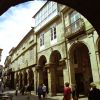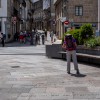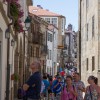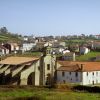- Accede I
- Regístrate I
- carrito
03. Hostal de los Reyes Católicos
03. Hostal de los Reyes Católicos
Galería de imágenes

En 1486 los Reyes Católicos, Isabel y Fernando, visitan Santiago. Los peregrinos vagaban enfermos por las calles; la atención médica se prestaba en pequeños hospitales promovidos por instituciones o incluso en casas de particulares, excepto a los leprosos, que eran recluidos en las afueras.
La visita de los monarcas no era casual. Aprovechando esta deficiencia, deciden fundar un hospital real, no sólo para centralizar y modernizar los servicios médicos, sino también para asentar la presencia real en la ciudad y en el no siempre obediente Reino de Galicia, a través de una sede monumental ubicada estratégicamente ante la catedral y el palacio arzobispal, y cercada con cadenas.
El proyecto se encarga al arquitecto Enrique de Egas y comienza a construirse en el año 1501. Se trata de un edificio de transición, en un estilo que se despide del gótico tardío y saluda los primeros aires del Renacimiento. La fachada está concebida como un altar o retablo. Si miramos a lo alto, veremos junto a la ventana a Santiago Apóstol, Jesús, la Virgen María y San Juan Evangelista. Justo debajo están representados los doce apóstoles. En la parte inferior de las carreras verticales, las figuras desnudas de Adán, a la izquierda, y Eva, a la derecha, son un signo de la llegada del nuevo clasicismo.
A ambos lados, los enormes escudos -el real a la izquierda y el imperial a la derecha- dan fe de la presencia monárquica, al igual que los medallones de la parte superior de la puerta principal, que representan a los fundadores Isabel y Fernando. El resto es una finísima ornamentación que la historia del arte describe como plateresca, por trabajar la piedra como si de piezas de plata se tratase. Los balcones fueron añadidos en el siglo XVII.
Lo que más impresionó a la gente cuando construyeron el hospital, que ya era un edificio imponente para su época, fue la ornamentada cornisa superior. Esta cadena pétrea que rodea toda la altura del edificio era muy admirada y descrita por los peregrinos que visitaban el hospital, sin olvidar las gárgolas, que representan a seres fabulosos, animales e incluso seres humanos en posiciones obscenas.
La vida del hospital estaba organizada para que los hombres ocupasen la mitad izquierda y las mujeres la derecha. En la planta baja se ubicaban las hospederías de peregrinos sanos, y en los pisos superiores las enfermerías o salas de los convalecientes más enfermos, también separadas por sexos y por clases sociales. Tres de las enfermerías tenían la particularidad de formar una T sobre la capilla, para que los pacientes pudieran observar el altar de dos pisos mientras se celebraba la misa. Esta capilla, de estilo gótico-renacentista, es Monumento Histórico-Artístico y está rodeada por cuatro hermosos patios a manera de claustros, dos de ellos renacentistas y dos barrocos.
La puerta que encontramos a la derecha de la fachada era la inclusa o el torno donde se abandonaba a los niños huérfanos o indeseados. Llegó a haber en el siglo XVIII más de 800 niños venidos de toda Galicia. Tras ser bautizados, eran distribuidos entre mujeres de las aldeas, a las que se les pagaba para que les diesen el pecho hasta los 2 años. Pero no siempre se cumplía. Y por las condiciones sanitarias de la época, sólo un 10 por ciento de los niños de la inclusa llegaban a los 7 años. No fue el caso de la escritora Rosalía de Castro, que fue bautizada en la capilla del Hospital. A pesar de ser registrada como hija de padres desconocidos, se libró de la inclusa al hacerse cargo de ella su madrina.
Estas instalaciones fueron ampliándose para atender las necesidades sanitarias de la ciudad, que llegaron a un punto crítico durante la hambruna del año 1769, cuando se registraron más de 4.300 enfermos.
El edificio fue hospital hasta 1954, momento en el que pasó a formar parte de la Red Nacional de Paradores. Por tanto, y en el sentido amplio del término, podemos considerarlo como uno de los hospedajes más antiguos del mundo.
Hoy, en recuerdo a tantos siglos de hospitalidad, los peregrinos modernos conservan un curioso privilegio: los diez primeros peregrinos que lleguen cada día con la credencial llamada “Compostela” y con un bono expedido por la Oficina del Peregrino, pueden disfrutar de una comida gratis en el elegante hotel de cinco estrellas.



































